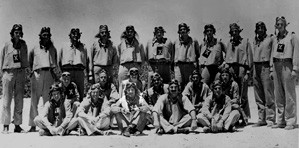In the annals of history, there have been great battles fought in nondescript locations, an epic struggle of arms elevating Gettysburg and Waterloo into places of prominence. Such was the case in the U.S. Navy’s most celebrated victory, a small atoll called Midway the focus of an attack by ships of the Imperial Japanese Navy that triggered one of the great carrier versus carrier engagements of the war.
Today, seventy-one years removed from the battle, there are few left to provide firsthand accounts of the battle that along with subsequent operations at Guadalcanal helped change the course of the Pacific War. Sadly, the passage of time has resulted in the dwindling in numbers of those who witnessed the Battle of Midway with their own eyes.
That was not the case in the mid-1990s when as part of the museum’s underwater aircraft recovery program, a SBD-2 Dauntless dive bomber (Bureau Number 2106) emerged from the waters of Lake Michigan, where it had crashed in 1943 during carrier qualification operations. Research into its history determined that during its active service the airplane had survived a flight against the Japanese fleet at Midway, returning to the atoll with its fuselage holed in over 200 places. The sole known surviving aircraft to have flown during the battle, it ranks as one of the most historic naval aircraft anywhere in the world.
Given the fact that the airplane flew with Marine Scout Bombing Squadron (VMSB) 241, manned by 1st Lieutenant Daniel Iverson, Jr. and Private First Class Wallace J. Reid, our research centered on trying to obtain recollections of members of that squadron, the letters they wrote to us back then now representing voices from the past on the 71st anniversary of the Battle of Midway. Interestingly, most did not comment on their respective flights against the enemy, instead focusing on other aspects of their experiences.
Life on Midway
Colonel Elmer Glidden, USMC
“Life on Midway preceding the battle was ‘different’ from anything any of us had known. For protection a series coral covered shelters were bulldozed along the outside of the runway area and essentially we lived ‘underground’ although because of the low water table the structures were above ground. When it rained, the decks were wet, and ventilation didn’t exist.”
Lieutenant Colonel Sumner H. Whitten, USMC
“Dugouts held 6-8 bunks, the ‘senior’ personnel rating the upper bunks. Only one bare light bulb, since all power was provided by venerable gas driven generators…We did have some recreation—baseball, volleyball, swimming, [and ] cards. Of course, fishing was fashionable. 1st Lt. Williamson and his gunner…specialized in Moray eels. They were awfully good eating—a great change from mullet when our meat and other foods ran out in May and June 1942…Showering and shaving in cold salt water left a lot to be desired…It was also in late May that we had to bury ALL personal belongings other than our clothes, watch, and pen and pencil, and could have no identifying articles on us except our dog tags.”
Visit of Admiral Nimitz to Midway
Major J. Douglas Rollow, USMC
“We could not imagine why Midway was so important…I remember that we were at attention when reviewed by Admiral Nimitz and he said, ‘At ease. All of you know me. I want to know you.’ We introduced ourselves and shook his hand.”
Squadron mate Captain Richard Fleming, Who Received the Medal of Honor Posthumously for Actions at Midway
LtCol Whitten
“Captain Fleming was a laughing, slightly sardonic character, and had the only library or collection of books. I can remember borrowing some of them—mostly modern classics. He was the squadron repository of all the dirty jokes, ribald songs, and always knew how to get recreational activity going. Fleming was a popular officer, a good pilot and flight leader. We all missed him.”
Training on Midway Prior to the Battle
Col. Glidden
“Our training was limited on Midway. We arrived there after Pearl Harbor and were on alert status most of the time. That meant dawn and dusk patrols and antisub patrols. We were flying SB2U-3s [Vindicator] right up to where we received SBDs [Dauntless] just before the battle. We had also received an influx of newer pilots, so actually the state of trained readiness was low. We had little time to check out in the SBDs—in my case 2 ½ hours prior to the battle.”
Duane L. Rhodes (gunner of Captain Leon Williamson)
“As far as training was concerned, one time, when we were on a [anti]submarine patrol, my pilot asked me if I would like to fire at a few white caps on the ocean. I believe he just wanted to know whether or not the gun would fire…The first moving target I ever fired at in the air was a Zero [that] was also shooting at me.”
Sense of Loss
LtCol. Whitten
“We all tried to believe that many more of our crews would be plucked from the seas…It was a quiet, serious series of days…lots of standing alerts and doing our best to put our planes into flying status…I guess we all finally just accepted our losses as part of being at war, just thanking Heaven that we were still on Earth…It was only after living through a couple of tight scrapes during my Guadalcanal tours that I finally realized how plain lucky I had been six months earlier.”
